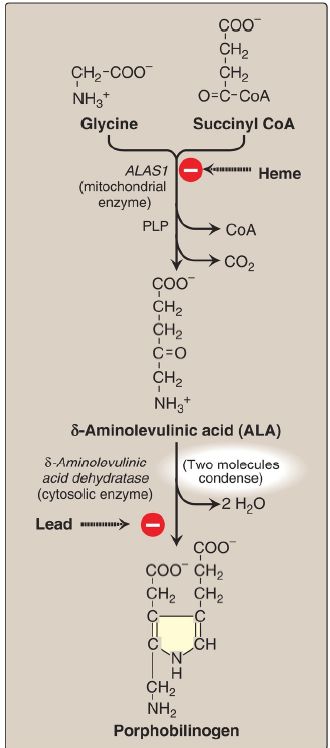
Heme Biosynthesis
 المؤلف:
Denise R. Ferrier
المؤلف:
Denise R. Ferrier
 المصدر:
Lippincott Illustrated Reviews: Biochemistry
المصدر:
Lippincott Illustrated Reviews: Biochemistry
 الجزء والصفحة:
الجزء والصفحة:
 12-11-2021
12-11-2021
 3082
3082
Heme Biosynthesis
The major sites of heme biosynthesis are the liver, which synthesizes a number of heme proteins (particularly the CYP proteins), and the erythrocyte-producing cells of the bone marrow, which are active in Hb synthesis. In the liver, the rate of heme synthesis is highly variable, responding to alterations in the cellular heme pool caused by fluctuating demands for hemeproteins. In contrast, heme synthesis in erythroid cells is relatively constant and is matched to the rate of globin synthesis. [Note: Over 85% of all heme synthesis occurs in erythroid tissue. Mature red blood cells (RBC) lack mitochondria and are unable to synthesize heme.] The initial reaction and the last three steps in the formation of porphyrins occur in mitochondria, whereas the intermediate steps of the biosynthetic pathway occur in the cytosol.
1. δ-Aminolevulinic acid formation: All the carbon and nitrogen atoms of the porphyrin molecule are provided by glycine (a nonessential amino acid) and succinyl coenzyme A (a tricarboxylic acid cycle intermediate) that condense to form δ-aminolevulinic acid (ALA) in a reaction catalyzed by ALA synthase ([ALAS], Fig. 1). This reaction requires pyridoxal phosphate ([PLP] ) as a coenzyme and is the committed and rate-limiting step in porphyrin biosynthesis. [Note: There are two ALAS isoforms, each produced by different genes and controlled by different mechanisms. ALAS1 is found in all tissues, whereas ALAS2 is erythroid specific. Loss-of-function mutations in ALAS2 result in Xlinked sideroblastic anemia and iron overload.]

Figure 1: Pathway of porphyrin synthesis: Formation of porphobilinogen. [Note: ALAS2 is regulated by iron.] ALAS = δ-aminolevulinic acid synthase; CoA = coenzyme A; CO2 = carbon dioxide; PLP = pyridoxal phosphate.
a. Heme (hemin) effects: When porphyrin production exceeds the availability of the apoproteins that require it, heme accumulates and is converted to hemin by the oxidation of Fe2+ to Fe3+. Hemin decreases the amount (and, thus, the activity) of ALAS1 by repressing transcription of its gene, increasing degradation of its messenger RNA, and decreasing import of the enzyme into mitochondria. [Note: In erythroid cells, ALAS2 is controlled by the availability of intracellular iron .]
b. Drug effects: Administration of any of a large number of drugs results in a significant increase in hepatic ALAS1 activity. These drugs are metabolized by the microsomal CYP monooxygenase system, a hemeprotein oxidase system found in the liver . In response to these drugs, the synthesis of CYP proteins increases, leading to an enhanced consumption of heme, a component of these proteins. This, in turn, causes a decrease in the concentration of heme in liver cells. The lower intracellular heme concentration leads to an increase in the synthesis of ALAS1 and prompts a corresponding increase in the synthesis of ALA.
2. Porphobilinogen formation: The cytosolic condensation of two ALA to form PBG by zinc-containing ALA dehydratase (PBG synthase) is extremely sensitive to inhibition by heavy metal ions (for example, lead) that replace the zinc (see 1). This inhibition is, in part, responsible for the elevation in ALA and the anemia seen in lead poisoning.
3. Uroporphyrinogen formation: The condensation of four PBG produces the linear tetrapyrrole hydroxymethylbilane, which is cyclized and isomerized by uroporphyrinogen III synthase to produce the asymmetric uroporphyrinogen III. This cyclic tetrapyrrole undergoes decarboxylation of its acetate groups by uroporphyrinogen III decarboxylase (UROD), generating coproporphyrinogen III (Fig. 2). The reactions occur in the cytosol.

Figure 2: Pathway of porphyrin synthesis: formation of protoporphyrin IX. (Continued from Fig. 1.) The prefixes -uro (urine) and -copro (feces) reflect initial sites of discovery. [Note: Deficiency in uroporphyrinogen III synthase prevents isomerization, resulting in production of type I porphyrins.]
4. Heme formation: Coproporphyrinogen III enters the mitochondrion, and two propionate side chains are decarboxylated by coproporphyrinogen III oxidase to vinyl groups generating protoporphyrinogen IX, which is oxidized to protoporphyrin IX. The introduction of iron (as Fe2+) into protoporphyrin IX produces heme. This step can occur spontaneously, but the rate is enhanced by ferrochelatase, an enzyme that, like ALA dehydratase, is inhibited by lead (Fig. 3).

Figure 3: Pathway of porphyrin synthesis: formation of heme b. (Continued from Figs. 1 and 2.) Fe2+ = ferrous iron.
 الاكثر قراءة في الكيمياء الحيوية
الاكثر قراءة في الكيمياء الحيوية
 اخر الاخبار
اخر الاخبار
اخبار العتبة العباسية المقدسة


